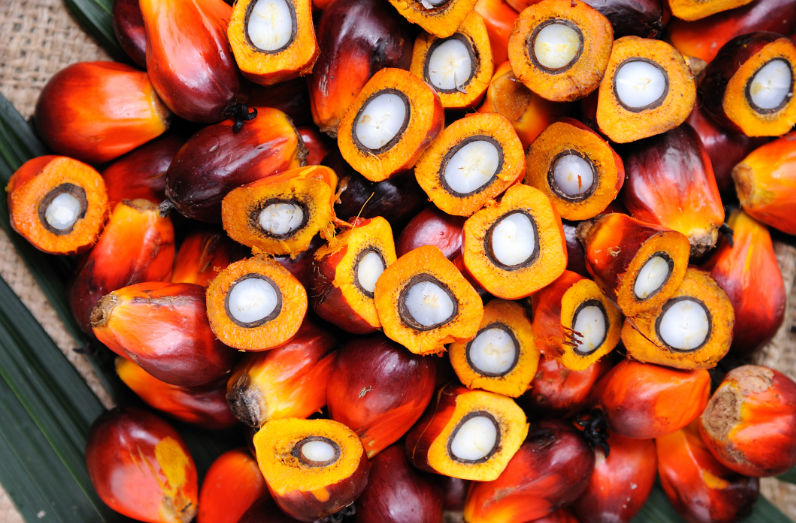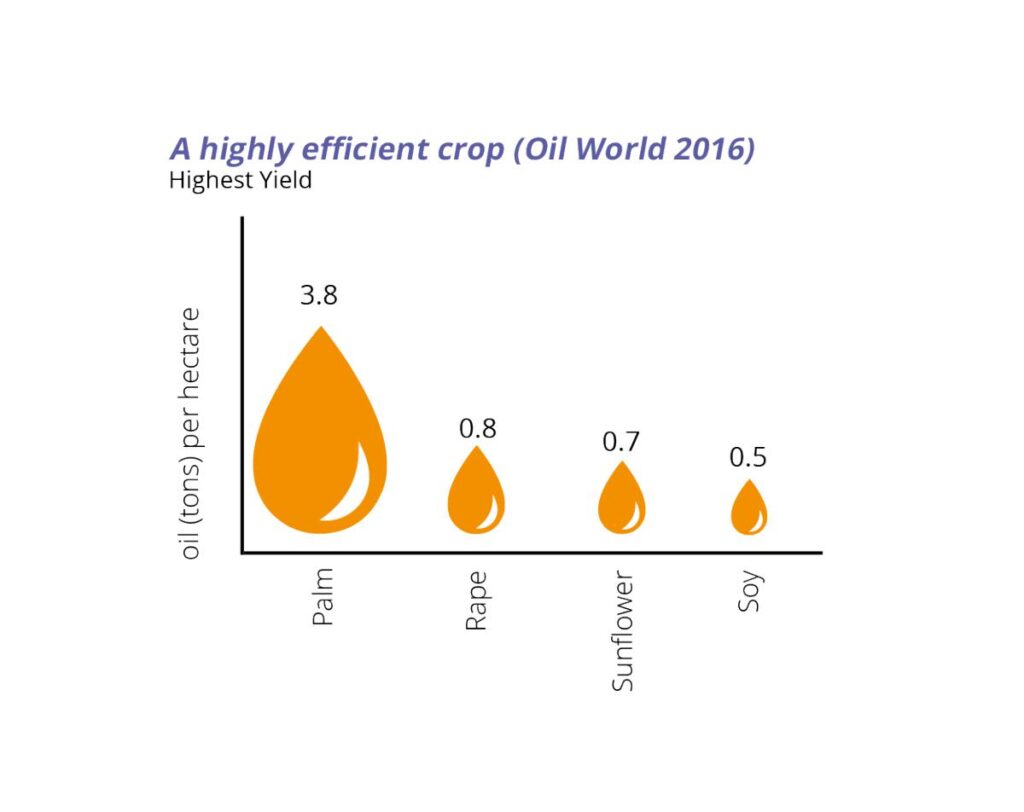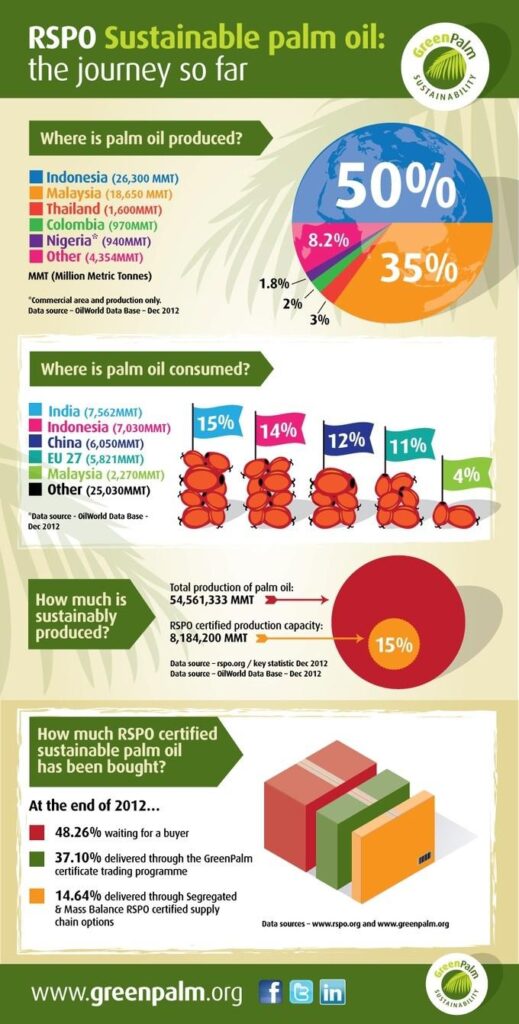Before we touch upon whether palm oil is hard to digest or not, we should understand what is palm oil made of? Should we be consuming palm oil at all?
These questions need to be asked since palm oil combines with a lot of stuff you eat regularly and so do its derivatives. Let us begin by understanding the main product.
Introduction to Palm Oil

Palm oil is extracted from the palm fruit (Elaeis guineensis). Studies hint at palm oil’s usage dating medieval times. Of course, back then, it was limited to southwest African lands. However, today, palm oil is considered to be one of the most consumed oils and has seen a very continuous rise in its demand.
It is used in half of the packaged and processed products to keep them fresh. Around 75% of all the palm oil produced goes into eateries and cosmetics like chocolates, biscuits, lipsticks, shampoos, toiletries, dyes etc. Having so many usages, it isn’t difficult to understand why palm oil is among one of the world’s most versatile products along with being the world’s most consumed vegetable oil as well.
Facts Related to Palm Oil
- Extracted from Nature: The forests of palm oil trees are usually found near the equator with Indonesia and Malaysia being the world’s largest cultivators. Palm kernel trees are tropical trees with about 5-meter-long leaves. When these trees grow older than three years, their fruits get ripped enough to harvest.
- Highest yield: Oil palm trees are one of the most efficient in terms of land usage. Among major oilseeds, they are the highest-yielding oil crops. They take 5.5% of all the land for fats and oils globally, and in just that small ration, they produce 32% of the output in total, which when compared to the requirement of the other oil seeds crop shows that palm oil can give yield in way lesser.

- Consumption of Palm oil: As I have already told you, palm oil is the most used vegetable oil. This isn’t so hard to understand considering it’s used in nearly everything you probably eat. So, the major market of the product resides in India, China, Indonesia, and EU countries.
- Fractions of Palm Oil: Fractionating refined palm oil entails splitting the oil into liquid (olein) and solid (stearin) fractions based on their different melting properties. Palm olein is mostly used as a cooking oil. Palm stearin, on the other hand, is often used to produce strong margarine and shortening materials. Later during the filtration, super olein, hard stearin, and palm mid fractions can be separated from palm olein. So, not only do we get advantages from palm oil, but even the side compounds left during its filtration and refining are useful. Moreover, the original palm oil, which is red in colour due to high caortenoid volume, is also useful for health betterment.
- Diverse uses: Palm oil is used in eatables such as chocolates, snacks, bread, butter, etc., and even in cosmetics. Lately, there have been speculations on whether we ought to use palm oil as a biofuel. It’s high in fats, carbon, and so, it seems like a plorable option. However, only times will tell how successful palm oil can be as a biofuel.
Will it conquer the fuel market as well? We don’t know that yet, but what we do know is that you can’t be putting anything in your car that isn’t engine oil.
Read more about engine oil in this piece.
Nutritional Information of Palm Oil
Needless to say, palm oil is rich in calories as other oils are too!
Calories in palm oil come from fat. Its breakdown of fatty acid is 50% saturated fatty acid, 40% monounsaturated fatty acid, and 10% polyunsaturated fatty acid. Palmitic acid is the main type of saturated acid found in palm oil and it contributes to 44% of its calories. This oil contains a high amount of oleic acid whereas a smaller amount of linoleic acid and stearic acid.
Palm oil is a great source of Vitamin E, which makes it rich in antioxidants. Vitamin E is important for keeping one’s immune system healthy and even helps cells in communicating better. Having enough Vitamin E in your diet would reduce the chances of having a heart attack i.e., strengthens the heart, reduces chances of having certain forms of cancer and age-related macular degeneration.
This oil also contains reddish-orange pigment stems from antioxidants known as carotenoids, which also includes beta-carotene, which our body can convert into Vitamin A. However, you should note that filtration processes deprive you of carotenoids. The red colour and palm stench is desired to be removed. So, red palm oil, which is the most original palm oil and rich in carotenoids, has to go through multiple refining processes and it eventually loses its best nutrient.
Eatables Containing Palm Oil

Palm oil could easily be found in certain packaged and processed eatables. While palm oil is the most efficient vegetable oil, its increasing demand and expansion threatens some core and sensitive habitats and parts of the world.
We shall be looking at some of the more devastating effects palm oil’s reckless cultivation has led us to. However, let us first understand the full scope it has in store for us.
Palm oil can be found in the following items:
- Bread: Most of the loaves of bread we buy from supermarkets will contain palm oil. The reason why palm oil is one of the most important ingredients used in bread making is that it doesn’t melt at room temperature, which means your bread won’t get all damp and soggy and the oil won’t leave the mixture. Palm oil is also a cheaper mixing fluid than most alternatives.
- Margarine: Margarine is used as a substitute for butter and dairy spreads very often, which shot to fame in the 80s because it didn’t contain trans fats. So, needless to say, if palm oil goes into margarine, it doesn’t contain trans fats as well. Moreover, it remains firm at room temperature and stops margarine from a chemical reaction with oxygen, which could make its taste funny and add a rather unpleasant odor.
- Pizza bases: Oven pizzas or ready-made pizza bases contain palm oil because it stops the toppings from sticking together and enhances the taste and texture.
- Chocolate: Palm oil is a credible raw material of chocolates. It is used because it helps in creating a smooth and shiny appearance in some chocolates and keeps them from melting.
- Ice Cream: It sounds so weird that an ice cream requires palm oil as an ingredient but yes, it’s true! Palm oil helps improve the temperature resistance and texture of your ice creams. Not something we’re shocked about, after all it is known for a smooth and creamy feel as well.
- Instant Noodles: Staple meal for budgeters and brunch addicts i.e. instant noodles also require palm oil because they are pre-cooked and all you have to do is add hot water. So, they need items which can heat up at certain temperatures but maintain firmness when devoid of heat. This means we need something which doesn’t melt easily at room temperature, but can heat when it is immediately insinuated. No wonder, your instant noodles contain approximately 20% palm oil.
- Cookies and Biscuits: They need to be crunchy just as much as they need to be silky. We need an ingredient which could help with the softness while also maintaining firmness. Semi-solid at room temperature, palm oil gives the baked cookies a creamy texture.
Digestion of Palm oil and Problems Related

Palm oil got a very bad reputation because it has a high volume of saturated fats, which have been linked to heart diseases and are hard to digest as well. Saturated fats are known to boost bad LDL cholesterol and triglycerides, both of them accumulating as fat because they are hard to digest and also deteriorate a heart’s condition. Palm oil is 50% saturated, having a more favorable fatty acid composition against palm kernel oil and coconut oil which are more than 85% saturated. In general words, the higher the saturated fat content, the more solid the fat is at room temperature. At room temperature, palm oil is semi-solid, but it can also be processed into liquid cooking oil.
However, truth be told: It is not as bad as trans fats!
Trans fat is considered to be the unhealthiest fat, which is now banned in most countries including America. Trans fat is known to increase the LDL and Triglyceride levels, and it also reduces ‘good’ HDL cholesterol. Most trans fat is generally created artificially with the process called hydrogenation. Many processed baked goods and snacks would use such calories. Moreover, a little bit of a hydrogenated oil was used by restaurants and hotels to fry items faster and cheaper.
Alternatives had to be found by food producers and restaurants. Palm oil is one of them. It lacks trans-fat and is found to be less saturated than butter. However, speaking from a digestive point of view, it wouldn’t really take your body too long to digest palm oil. All thanks to an enzyme that goes by the name of pancreatic lipase!
The pancreatic lipase will decompose the palm oil fat into smaller compounds like the fatty acids that palm oil is known for. Do mind that it’s not a chore for your body to absorb these compounds. So, it comes to us with no wonder that refined palm oil along with some of its other by-products that get made in the filtration process are 95% digestible.
Effects on Health
Advantages
Palm oil may not be the healthiest choice in the lot and most occasions, it does take a back seat when you compare it with jojoba, macadamian, etc. However, it is not without saying that palm oil is rich in vitamins and plenty of brain and heart essentials.
You want to read more on healthy oils? Click here!
Let us dig deep:
- Brain Health: Palm oil doesn’t come alone but also brings tocotrienols into your body. Tocotrienols are strong antioxidants, which improve your brain’s working as they protect the polyunsaturated fats your brain so needs! Studies also back up that palm oil can reverse mental aging and slow down tumor growth.
- Heart Health: Now I know palm oil isn’t olive oil, the healthiest fat out there! However, you would be surprised to know that palm oil has been found, by many studies, to lower LDL cholesterol, the bad cholesterol. In fact, studies go so far as to say that people who consume palm oil are less likely to have a cholesterol problem!
- More Vitamin A: Palm oil has been linked with vitamin supplementary qualities. Pregnant women and younger children are encouraged to follow a moderate consumption diet with palm oil rich ingredients. However, please note that certain bad effects might be a hindrance. You should consult your obstetrician before you take up a new meal chart.
Disadvantages
- Increasing Bad Cholesterol Level: Yes, we said it just a few paragraphs back that palm oil lowers your bad cholesterol. However, some studies hint otherwise, and so, we thought it would be more fair to report both the sides. Although most studies record that palm oil only has good effects on health, others have reported conflicting results. One study conducted in women with high cholesterol showed that levels of small and dense LDL (type of cholesterol linked with heart diseases) increased with the intake of palm oil, whereas the same parameters have decreased with an intake of other oils. It’s also important to note that these are just potential risks and not a piece of evidence that palm oil can actually cause heart diseases.
- Linked to Atherosclerosis: Please note that the older your oil gets the more values it loses, and that is the case with palm oil! Fresh palm oil and old palm oil show significant changes in tocotrienol levels. Because of this, old palm oil shows very few benefits in comparison to fresh palm oil. It may increase the risk of heart diseases such as atherosclerosis.
- High in Saturated Fats: Compared to other liquid oils, the level of saturated fats is relatively higher in palm oil. Palm oil is about 34% saturated fat. Saturated fat is directly linked to problems related to heart diseases and chronic health conditions.
Effects of Mass Production on the Environment
Palm oil products cause certain adversities in the environment because of how palm oil is produced. Because it’s grown in tropical rainforest regions around the globe, vast plantations of palm oil led to deforestation and widespread cutting down of natural forests.
Certain environmental organizations have time and again stated that in Indonesia alone, every hour 300 football grounds worth of good forest area is chopped off to make some room for palm kernel farming.
No wonder that Indonesia has now become one of the world’s largest Carbon dioxide producers because they don’t go around chopping those trees literally, but they rather set them on fire.
According to a study, by 2025, palm oil production worldwide is predicted to triple between 120 to 150 million tonnes.
Conclusion
Palm oil is one of the most used vegetable oils in the world with a constant increasing demand worldwide. Having been used in almost everything and utilized in our day-to-day life makes it an unavoidable ingredient of our lives.
With no trans fat and higher levels of saturated fats, palm oil is easy to digest, but, it can have some adverse effects on health. Moreover, this also affects the environment on a very huge scale. Finding some alternatives to palm oil can bring the pressure down and balance the supply and demand more environmentally.

